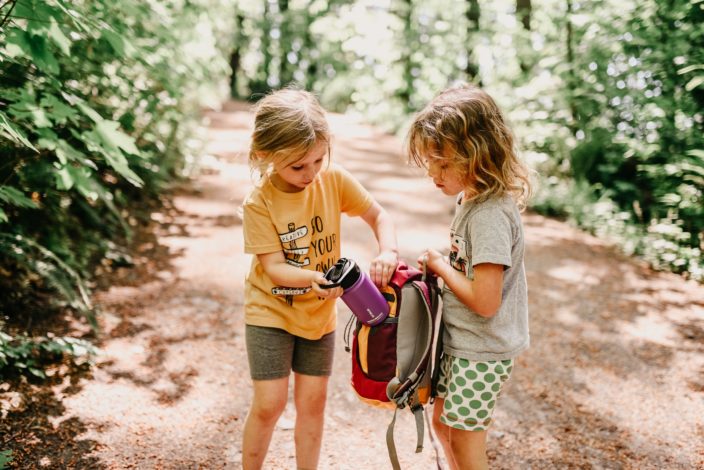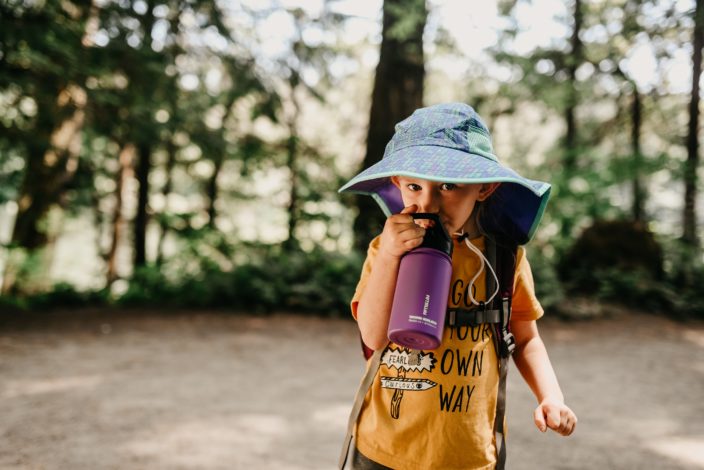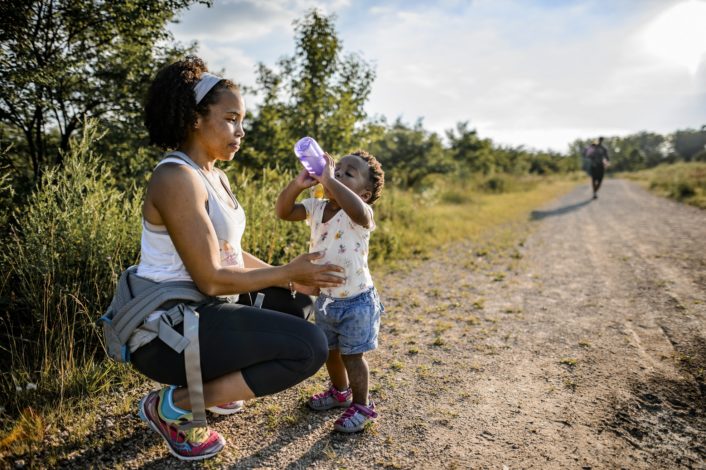Dehydration on the Trail: Signs, Prevention and Treatment
If you live in an extremely hot climate or are traveling somewhere where the heat is more than you are used to, it's very important to monitor your hydration while hiking and to watch for signs and symptoms of dehydration in yourself and your little one(s).
Nurses Paula Fortin, ANP, FNP (Former Pediatric ICU nurse, ER nurse, Lifemed Flight Nurse) and Thuy Le (Neonatal ICU RN, Staff Registered Nurse at Dell Children Medical Center, NICU) provide tips for preventing dehydration and how to recognize the signs of dehydration.


 Paula: For toddlers and bigger kids, water is best, but you may also supplement with electrolyte drinks if the physical activity has been very strenuous and temperatures are hot. (However, watch for excessive sugars, artificial sweeteners and dyes, and do not make these a regular part of their fluid intake.) Energy drinks are NEVER okay for children. Ideally, you won’t reach the dehydration phase by offering a drink every 20-30 minutes to active children. If you do, start slowly, offering small sips at a time. Having a huge glass of fluid can make them feel sick and vomit, worsening the dehydration. Remove them from the full sunshine into a cool, shaded area to rest and continue to give fluids.
Thuy: During sports or exercise and on warm days, your child needs to drink more often than usual. He may need to drink up to 8 ounces of water every 20 minutes. If nursing, breastfeed your baby more often or offer him extra formula. If he urinates less than usual or his urine is darker, give him more fluids. Babies should have 4-6 wet diapers each day.
Paula: For adults, follow the same rules of offering fluids slowly and staying in a cool, shaded environment. If you or the little ones start to have muscle cramps, abdominal cramps, nausea, vomiting, dizziness, weakness or headaches, you are experiencing heat exhaustion which, if not treated immediately, can lead to heat stroke, seizures, loss of consciousness and even death.
In conclusion, we should attempt to prevent dehydration as a high priority when hiking, but if it still occurs, there are ways to treat dehydration while on the trail. Here are some summaries from websites concerning children and dehydration:
Mild to Moderate Dehydration:
• Plays less than usual
• Urinates less frequently (for infants, fewer than six wet diapers per day)
• Parched, dry mouth
• Fewer tears when crying
• Sunken soft spot of the head in an infant or toddler
• Stools will be loose if dehydration is caused by diarrhea; if dehydration is due to other fluid loss (vomiting, lack of fluid intake), there will be decreased bowel movements
Severe Dehydration (in addition to the symptoms and signals already listed):
• Very fussy
• Excessively sleepy
• Sunken eyes
• Cool, discolored hands and feet
• Wrinkled skin
• Urinates only one to two times per day
Keep safe on those trails, hikers!
Photos by Deanna Curry and Laura Castro.
Paula: For toddlers and bigger kids, water is best, but you may also supplement with electrolyte drinks if the physical activity has been very strenuous and temperatures are hot. (However, watch for excessive sugars, artificial sweeteners and dyes, and do not make these a regular part of their fluid intake.) Energy drinks are NEVER okay for children. Ideally, you won’t reach the dehydration phase by offering a drink every 20-30 minutes to active children. If you do, start slowly, offering small sips at a time. Having a huge glass of fluid can make them feel sick and vomit, worsening the dehydration. Remove them from the full sunshine into a cool, shaded area to rest and continue to give fluids.
Thuy: During sports or exercise and on warm days, your child needs to drink more often than usual. He may need to drink up to 8 ounces of water every 20 minutes. If nursing, breastfeed your baby more often or offer him extra formula. If he urinates less than usual or his urine is darker, give him more fluids. Babies should have 4-6 wet diapers each day.
Paula: For adults, follow the same rules of offering fluids slowly and staying in a cool, shaded environment. If you or the little ones start to have muscle cramps, abdominal cramps, nausea, vomiting, dizziness, weakness or headaches, you are experiencing heat exhaustion which, if not treated immediately, can lead to heat stroke, seizures, loss of consciousness and even death.
In conclusion, we should attempt to prevent dehydration as a high priority when hiking, but if it still occurs, there are ways to treat dehydration while on the trail. Here are some summaries from websites concerning children and dehydration:
Mild to Moderate Dehydration:
• Plays less than usual
• Urinates less frequently (for infants, fewer than six wet diapers per day)
• Parched, dry mouth
• Fewer tears when crying
• Sunken soft spot of the head in an infant or toddler
• Stools will be loose if dehydration is caused by diarrhea; if dehydration is due to other fluid loss (vomiting, lack of fluid intake), there will be decreased bowel movements
Severe Dehydration (in addition to the symptoms and signals already listed):
• Very fussy
• Excessively sleepy
• Sunken eyes
• Cool, discolored hands and feet
• Wrinkled skin
• Urinates only one to two times per day
Keep safe on those trails, hikers!
Photos by Deanna Curry and Laura Castro.

Preventing Dehydration
Paula: Monitoring for dehydration while out hiking and walking is important for babies, toddlers and kids of all ages (yep, that means you too, mom and dad!). Adults usually carry the water supply while hiking with younger families and have the easiest time staying hydrated (if they aren’t too distracted by saving the young adventurers from whatever mayhem they are falling into). When it’s hot outside, we all sweat more and lose fluids rapidly, especially when our heart rate and respiratory rate are up. Babies aren’t able to regulate their temperatures the way adults can, so monitoring their temps is very important. They have a large surface area and can lose fluids much faster than we would expect. This requires attentive caregivers to make sure babies and toddlers stay hydrated. Consider dressing kids in breathable clothing, maybe even light-colored long sleeves, to protect against excessive sun exposure and a hat to protect faces and necks. Offering a drink break every 20-30 minutes when active can prevent dehydration. If your baby/child has recently been ill with dehydration or vomiting, make sure they start the activity well hydrated. If they aren’t, perhaps wait another day or two before engaging in activities that can lead to fluid loss. Parents who are carrying babies or small children are at increased risk of dehydration as you have an extra little “furnace” attached to your body. Be sure to maintain adequate intake of fluids before you start your hike and during. You may even consider a “kool-tie” that wraps around your neck and keeps you cool. While dehydration might seem like a small concern, it can cause serious problems and even lead to death in severe cases. Learning the signs of dehydration is crucial to keeping kids safe. Thuy: Wear lightweight, loose and light-colored clothing. Protect your head and neck with a hat or umbrella when you are outdoors. Drink lots of water or sports drinks. Avoid alcohol. Eat salty foods, such as salted crackers and pretzels. Limit your activities during the hottest time of the day. This is usually late morning through early afternoon. Use air conditioners or fans and have enough proper ventilation. If there is no air conditioning available, keep your windows open so air can circulate. Never leave children alone inside the car, especially during hot weather. Always carry water or coconut water.
Signs and Symptoms
Paula: Signs of dehydration in infants may include: fewer wet diapers than usual, dry tongue and lips, no tears when crying, strong smelling or dark urine, irritability or lethargy (sleepiness). In severe cases, the babies “soft spot” or fontanel may be sunken, and hands and feet can be cold and mottled. For toddlers, you may see thirst, dry tongue/mouth, fewer pee stops or wet diapers, and lethargy or irritability. Thuy: Signs of dehydration in children will include: Dry mouth and child may not want to drink any liquids; tired, restlessness and fussiness; very sleepy or will not wake up; sunken eyes or crying without tears; urinating very little or not at all, or have dark yellow urine; cold, pale feet and hands. Paula: Bigger kids or adults may feel irritability, have dry tongue/mouth and feel thirsty with fewer pee stops, or feel hot to the touch and no longer sweating. By the time we experience thirst, we have already lost 2% of our body weight in fluids. If you see any of these signs, immediately stop the activity, get into the shade and start offering fluids. Thuy: Also be aware of the signs of heat stroke. Your temperature is 104 or higher. Your skin may be red, dry or clammy. You have a headache, nausea or vomiting, and experience muscle cramps. You breathe fast or feel like your heart is beating faster than normal. You feel faint, dizzy, weak or tired. You may have a prickling feeling in your arms or legs. You may have a seizure or faint.How to stay hydrated and treat dehydration
Paula: For babies less than 3 months, breast milk or their formula is best. Over 3 months of age, you can consider an electrolyte replacement such as Pedialyte to supplement breast milk or formula. Plain water should not be given to babies less than 6 months or those who are not taking solids as this can cause significant changes in their delicate electrolyte balance and cause seizures. Thuy: If your child is dehydrated, babies should continue to breastfeed or drink formula. Your child should not be fed solid food until the dehydration has been treated. If your child has diarrhea or is vomiting, offer foods he usually eats as soon as possible. He may need an oral rehydration solution like Pedialyte or coconut water), which contains the right amount of salt, sugar and minerals. He can be given the fluid in small amounts, or about 1 teaspoon at a time if your child is vomiting. If your child vomits, wait 30 minutes and try again. Do not give your child soft drinks or juices. These can make his condition worse. IV fluid may be needed if his condition is severe. Paula: For toddlers and bigger kids, water is best, but you may also supplement with electrolyte drinks if the physical activity has been very strenuous and temperatures are hot. (However, watch for excessive sugars, artificial sweeteners and dyes, and do not make these a regular part of their fluid intake.) Energy drinks are NEVER okay for children. Ideally, you won’t reach the dehydration phase by offering a drink every 20-30 minutes to active children. If you do, start slowly, offering small sips at a time. Having a huge glass of fluid can make them feel sick and vomit, worsening the dehydration. Remove them from the full sunshine into a cool, shaded area to rest and continue to give fluids.
Thuy: During sports or exercise and on warm days, your child needs to drink more often than usual. He may need to drink up to 8 ounces of water every 20 minutes. If nursing, breastfeed your baby more often or offer him extra formula. If he urinates less than usual or his urine is darker, give him more fluids. Babies should have 4-6 wet diapers each day.
Paula: For adults, follow the same rules of offering fluids slowly and staying in a cool, shaded environment. If you or the little ones start to have muscle cramps, abdominal cramps, nausea, vomiting, dizziness, weakness or headaches, you are experiencing heat exhaustion which, if not treated immediately, can lead to heat stroke, seizures, loss of consciousness and even death.
In conclusion, we should attempt to prevent dehydration as a high priority when hiking, but if it still occurs, there are ways to treat dehydration while on the trail. Here are some summaries from websites concerning children and dehydration:
Mild to Moderate Dehydration:
• Plays less than usual
• Urinates less frequently (for infants, fewer than six wet diapers per day)
• Parched, dry mouth
• Fewer tears when crying
• Sunken soft spot of the head in an infant or toddler
• Stools will be loose if dehydration is caused by diarrhea; if dehydration is due to other fluid loss (vomiting, lack of fluid intake), there will be decreased bowel movements
Severe Dehydration (in addition to the symptoms and signals already listed):
• Very fussy
• Excessively sleepy
• Sunken eyes
• Cool, discolored hands and feet
• Wrinkled skin
• Urinates only one to two times per day
Keep safe on those trails, hikers!
Photos by Deanna Curry and Laura Castro.
Paula: For toddlers and bigger kids, water is best, but you may also supplement with electrolyte drinks if the physical activity has been very strenuous and temperatures are hot. (However, watch for excessive sugars, artificial sweeteners and dyes, and do not make these a regular part of their fluid intake.) Energy drinks are NEVER okay for children. Ideally, you won’t reach the dehydration phase by offering a drink every 20-30 minutes to active children. If you do, start slowly, offering small sips at a time. Having a huge glass of fluid can make them feel sick and vomit, worsening the dehydration. Remove them from the full sunshine into a cool, shaded area to rest and continue to give fluids.
Thuy: During sports or exercise and on warm days, your child needs to drink more often than usual. He may need to drink up to 8 ounces of water every 20 minutes. If nursing, breastfeed your baby more often or offer him extra formula. If he urinates less than usual or his urine is darker, give him more fluids. Babies should have 4-6 wet diapers each day.
Paula: For adults, follow the same rules of offering fluids slowly and staying in a cool, shaded environment. If you or the little ones start to have muscle cramps, abdominal cramps, nausea, vomiting, dizziness, weakness or headaches, you are experiencing heat exhaustion which, if not treated immediately, can lead to heat stroke, seizures, loss of consciousness and even death.
In conclusion, we should attempt to prevent dehydration as a high priority when hiking, but if it still occurs, there are ways to treat dehydration while on the trail. Here are some summaries from websites concerning children and dehydration:
Mild to Moderate Dehydration:
• Plays less than usual
• Urinates less frequently (for infants, fewer than six wet diapers per day)
• Parched, dry mouth
• Fewer tears when crying
• Sunken soft spot of the head in an infant or toddler
• Stools will be loose if dehydration is caused by diarrhea; if dehydration is due to other fluid loss (vomiting, lack of fluid intake), there will be decreased bowel movements
Severe Dehydration (in addition to the symptoms and signals already listed):
• Very fussy
• Excessively sleepy
• Sunken eyes
• Cool, discolored hands and feet
• Wrinkled skin
• Urinates only one to two times per day
Keep safe on those trails, hikers!
Photos by Deanna Curry and Laura Castro.
Related Content




Comments